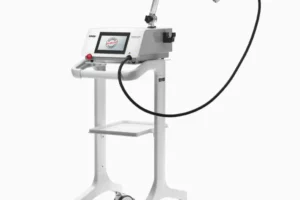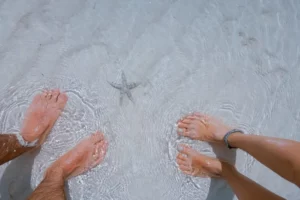“Shockingly” good results for Plantar Fasciitis and Achilles Tendinopathy!
Today’s blog is an introduction to Extracorporeal Shockwave Therapy, which is gathering popularity in treating the dreaded conditions of Plantar Fasciitis and Achilles Tendinopathy due to its ability to accelerate healing time and reduce pain!
What is Extracorporeal Shockwave Therapy (ESWT)?
ESWT is an acoustic sound wave that transfers from the point of origin which is a handheld projectile applicator, to the target area which is usually the site of injury in a muscle, tendon or bone. ESWT was originally used to blast and fragment kidney stones as it can penetrate deep into the body from the outside without the need for surgery. The word extracorporeal means “outside the body” and shockwave means “pressure waves”.
How does ESWT work?
The kinetic energy of the projectile sound wave is transferred to the transmitter at the end of the applicator, where it travels through the tissues to the site of injury. The shockwave then causes a cavitation effect, a bit like the ripple effect when you throw a stone in a pond, this is when the shockwave promotes regeneration and reparative processes of the bones, tendons and other soft tissues. The exact physiological mechanism is not entirely understood, however research suggests that the cells at the site of injury undergo microtrauma which promotes the formation of new blood vessels and nerve cells and also inflammatory processes that are associated with the healing process.
What conditions benefit from ESWT treatment?
Studies show ESWT to be beneficial in treating a range of lower limb musculoskeletal conditions not limited to: Plantar Fasciitis (now referred to as Plantar Fasciopathy), Achilles Tendinopathy, Medial Tibial Stress Syndrome (Shin Splints), Bursitis, Morton’s Neuroma, Stress Fractures, Plantar Fibromatosis, Avascular Necrosis, Sever’s Disease, Calcifying Tendinopathies, Osgood Schlatters and Myofascial Injury.
ESWT is a non-invasive treatment with very few side effects that is reported to accelerate healing times and reduce pain in conditions that have been unresponsive to conventional treatment approaches.
How effective is ESWT in treating Plantar Fasciitis and Achilles Tendinopathy?
There are two good quality research studies that have investigated the benefits of ESWT in the treatment of Plantar Fasciitis. The level 1 trial conducted by Gerdesmeyer, Frey, Vester et al (2010) concluded that ESWT significantly improved pain, function, and quality of life compared with placebo in patients with resistant cases of Plantar Fasciitis. SImilar findings were also reported by Ibrahim et al (2010).
For Achilles Tendinopathy a series of level 1 trials conducted by Rompe et al (2009) concluded at 4-month follow-up that eccentric loading exercises alone were less effective when compared with a combination of eccentric loading exercises and a course of low-energy shock-wave treatments.
Are there any reasons someone may not be able to have ESWT?
- Clotting disorders/anticoagulants. As shockwave can (at high pressure or frequency) cause bleeding, patients in this group should be treated with caution.
- Infection. As shockwave can increase cell production this may not be a positive effect where there is infection.
- Cancer. Similar to infection, shockwaves to cancerous tissue could encourage cell growth.
- Corticosteroid injection. There is evidence to suggest that as steroid injections weaken soft tissues, further immediate treatment with shockwave could cause tendon rupture or tissue damage. Generally it is recommended to allow a 6 week window between a steroid injection and having ESWT.
Are there any side effects?
ESWT has very few side effects and has been deemed a safe treatment by the National Institute of Clinical Excellence (NICE). In some cases, treatment may cause localised redness to the skin, bruising and minor swelling. The procedure can also be painful during administration but in most cases causes an analgesic effect immediately after treatment which can last for a few days.
How many treatment sessions are needed?
The number of sessions needed for a desirable outcome depends on the nature and length of time the condition has been present. In Plantar Fasciitis and Achilles Tendinopathy the latest research suggests that the earlier ESWT is administered, the less sessions are needed. So in cases where injury has been present for a few weeks, up to three ESWT treatments may be enough, whereas in more chronic cases of over six months, six to twelve sessions may be required to achieve a successful outcome.
“I am an Advanced Musculoskeletal Podiatrist with special interests in extracorporeal shockwave therapy, video gait analysis and lower limb tendon and fascia injuries. I provide consultancy services to Electromedical Systems on their extracorporeal shock wave machines and am the UK trainer for the Optogait video gait analysis system for Algeos Ltd. My experience extends to providing specialist consultancy and management of lower limb conditions to elite and professional athletes, military personnel, recreational sports people and the general population. My purpose is to improve my patient’s’ quality of life and get them back to achieving their goals whether it’s walking the dog, getting through a compulsory fitness test, running a marathon or competing in an international event.” Emily Ball, Clinical Director, Active Step Healthcare Ltd.



